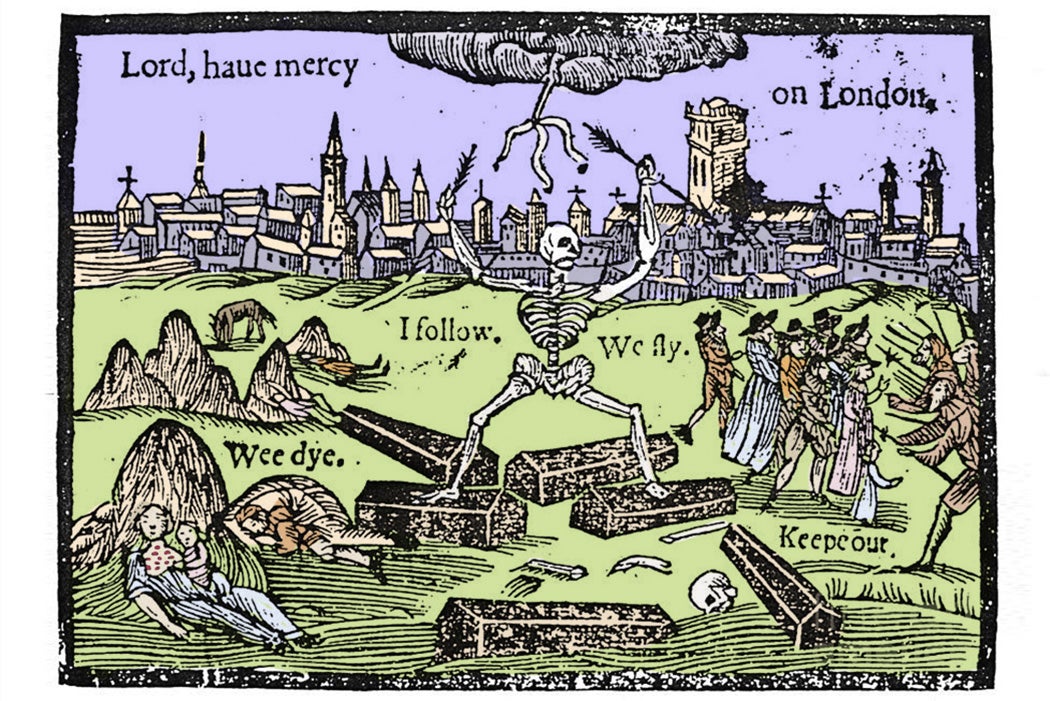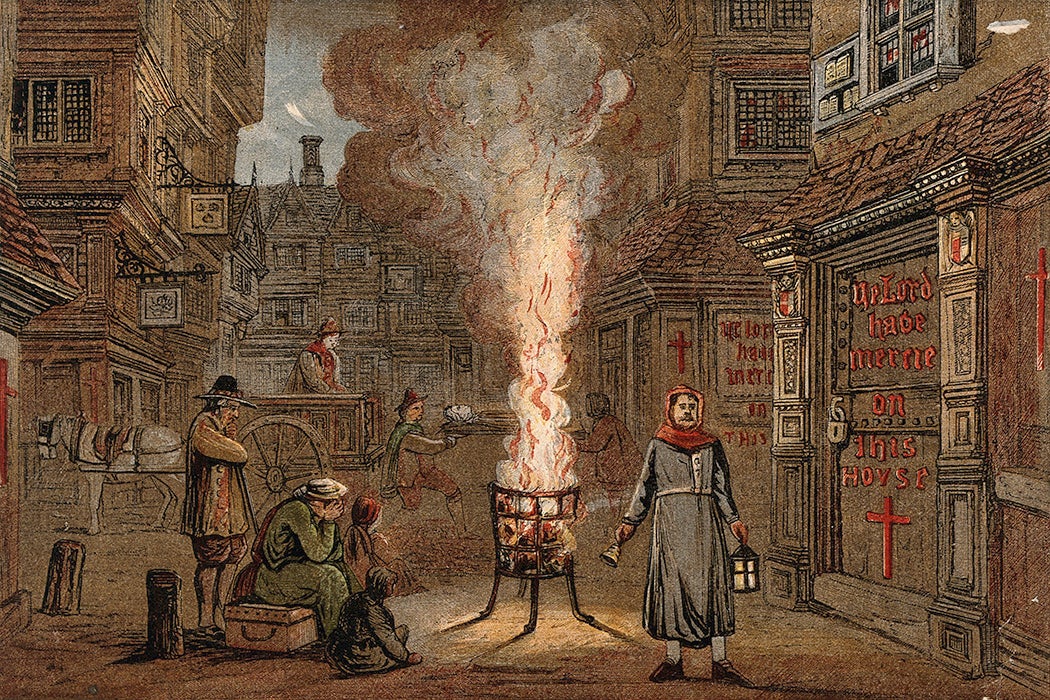A deadly and contagious illness sweeps the country, and strict quarantine measures are swiftly implemented. The death count rises, but government reporting is unreliable. Social isolation takes its toll as political tensions escalate. Citizens break government mandates, asserting their right to work. Neighbors turn on each other. In response to long-standing social injustices, riots break out, and protesters demand systemic change. Sound familiar?
While the parallels are striking, this is not a description of 2020. It’s a description of early modern England. Starting with the Black Death, in 1348, and continuing for more than 300 years, Europe was struck with incessant waves of plague. In England, this proved especially deadly between 1563 and 1666, when multiple epidemics hit London. The social response generated by these outbreaks mirrors what we are experiencing today. Plague and protest, in short, are correlated.
Weekly Newsletter
Scholars like Philip Ziegler and Mark Senn have argued that the Black Death of 1348 laid the groundwork for the Peasants’ Revolt of 1381, the first large-scale popular revolt in England. As they explain the connection, the Black Death killed more than half of the English population. Severe labor shortages gave peasants the upper hand, and an opportunity to demand an end to serfdom.
During the Peasants’ Revolt, peasants executed members of the Royal government, broke open jails, and burned public buildings. Although plague and protest did not occur concurrently—the revolt itself occurred thirty years after the Black Death swept through Europe—Senn suggests the plague exacerbated the oppressive social conditions that already existed in London, leading to revolt. In essence, economic grievances—increased fines and taxes, high rents, fixed incomes—were the basis of the revolt.

Fast-forward to the sixteenth century. Haunted by the memory of the Black Death, the English government worked quickly to quell plague when it reappeared. Queen Elizabeth I issued her official Plague Orders sometime in 1578, requiring entire households, both healthy and sick, to be quarantined together for six weeks or forty days (the term quarantine comes from the Venetian quarantena, meaning forty). But, as with the 2020 protests against government-mandated “Stay at Home” orders that saw armed protesters storming the Michigan Statehouse, many refused to comply with the orders. In his 1596 medical manual, the physician Paracelsus complains:
[W]hat a madness and cruel foolishness is this, that in the time of any great plague, such as are infected, you shut up in houses, set marks upon them, keep them in prison, strangle them with cares and solitariness, and kill them for hunger: is the plague so to be cured?
The poet George Wither articulated a similar complaint during a 1625 outbreak:
So when our Sickness, and our Poverty
Had greater wants than we could well supply;
Strict Orders did but more enrage our grief,
And hinder in accomplishing relief.
These “strict orders” were seen as a burden, and many considered the cure worse than the disease.
Londoners bent on flouting the Plague Orders found the public health rationale unconvincing. As Kira Newman notes:
[C]ontrary to this government narrative of disease prevention there was a popular narrative that portrayed quarantine and isolation as personal punishment rather than prudent policy.
The playwright Thomas Dekker describes the rejection of early modern “social distancing” with derision:
If you look into the Fields, look into the Streets, look into Taverns, look into Ale-houses; they are all merry, all jocund; no Plague frights them, no Prayers stir up them, no Fast ties them to obedience. In the Fields they are… walking, talking, laughing, toying, and sporting together. In the Streets, blaspheming, selling, buying, swearing. In Taverns, and Ale-houses, drinking, roaring, and surfeiting.
He marvels at the lack of precaution, much the way the U.S. media marveled at spring breakers in March 2020.
Londoners simply grew tired of following the rules. As one personal letter from 1665 explains:
Death is now become so familiar, and the People so insensible of danger, that they look upon such as provide for the public safety, as Tyrants and Oppressors.
As Newman notes, citizens perceived public health policies as tyrannical and defied the Plague Orders, both openly and in secret. For instance, Stephen Smyth, a fishmonger, was arrested for selling fish while quarantined. Jeremy Wright, a gentleman, physically assaulted a constable and his assistant when they tried to shut up his house. Such desperate times led many to secrecy, criminality, and violence.

Lack of compliance posed a constant problem. The Privy Council condemned “the great negligence and remiss slackness of the citizens” who refused to follow public health protocol. Robert Cecil, advisor to Queen Elizabeth I, complained about the “unruly infected.” Subsequent Plague Orders added physical punishments to enforce compliance. Starting in 1604, anyone found in public with plague sores could be hanged, and anyone who secretly escaped household quarantine could be whipped.
The government claimed that these harsh measures were deployed for the good of the community to prevent another Black Death. However, as Newman shows, such harsh measures led to “a sense of inequity and penalization” among the middle class. These were mostly small business owners like “coachmakers, grocers, fishmongers, tailors, and innholders” who “lacked the resources to endure long periods of expenditure without income.” The middle class faced a unique threat to their status and livelihood. Not being poor enough to receive much government assistance, they also weren’t wealthy enough to flee the city—a burden not felt by more affluent Londoners. Wealthy individuals who chose to remain in the city were less affected. While they could afford to quarantine without work for forty days, they were also able to hide evidence of sickness within their spacious homes, effectively avoiding quarantine altogether.
While some protested the Plague Orders to protect their livelihoods or preserve their freedoms, others protested because they insisted it was their Christian duty to extend a charitable hand to neighbors in need. Although quarantine laws were enacted for the greater good, the laws contradicted the standards of morality outlined by the Church. According to Graham Hammill, such a discrepancy between legality and spirituality “initiated a debate over the means by which the state should preserve and safeguard the existence of its population.”
While Elizabeth I’s Plague Orders were proclaimed an act of charity, they sent the message that “charity no longer simply indicates care for the sick. It also indicates protection against the sick.” Quarantine laws called for the desertion of sick neighbors—something that invited fears of religious retribution and moral decay. These fears ultimately transformed into public dissent as Plague Order protesters argued that “lack of neighborly care” was inherently worse than the “danger of infection.”
This same ethic of “neighborly care” suddenly took center stage on May 25, 2020, when George Floyd was murdered in Minneapolis. Protesters gathered en masse in more than 2,000 cities, all 50 states, and more than 60 countries. The tense conditions of the COVID-19 pandemic—social isolation, powerlessness, frustration—helped propel the Black Lives Matter movement, originally founded in 2013, back onto the global stage.
As one Washington Post article suggests, “the virus was the kindling, and the police brutality lit the fire.” While many protests demand equality, not all protests are created equal. Demanding racial justice and an end to police brutality, the gravity of the Black Lives Matter protests certainly eclipses the demands of the anti-“Stay at Home” protests. One declares, “I Want a Haircut.” The other, “I Want My Boys & Men to Live.” In short, despite concerns about the spread of COVID-19, contemporary Black Lives Matter protesters decided that neighborly care outweighed potential health concerns.
Weighing the risks of breaking quarantine to protest can be especially challenging when public health information is not reliable. Early Modern Londoners were apt to protest strict plague policies. And given that strict plague policies were tied to higher reported rates of death, local governments would purposely underreport plague. Samuel Pepys, an administrator of the English Navy and a Member of Parliament, noted the vast discrepancy in a diary entry dated August 31, 1665: “In the City died this week 7,496, and of them 6,102 of the plague. But it is feared that the true number of the dead this week is near 10,000.”
While endangering public health, this strategy did keep civil unrest to a minimum. Not only did the English government purposefully misreport plague, they used it as an excuse to quell otherwise unrelated social uprisings. It is widely known that playhouses in London were periodically closed due to plague, but this was also a time of “social disorder and protest,” as Mihoko Suzuki writes in the journal Criticism.
As Barbara Freedman noted in English Literary Renaissance, theater closures actually tend to coincide more with popular riots than with plague. From food riots led by hungry laborers, to worker’s rights riots led by mistreated apprentices, officials used the excuse of “plague” to curtail large gatherings that they found threatening. For instance, in 1580, a letter from the Lord Mayor to the Privy Council cited “great disorder” as the reason for his request to close the theaters. The Privy Council agreed, but instead cited the threat of infection as the reason. As Freedman succinctly puts it, “plague restraints were used as a means of social control.”
Much like the Black Death, which paved the way for the Peasants’ Revolt in the fourteenth century, or the plague outbreaks that set the stage for the Apprentice Riots of the 1590s, the COVID-19 pandemic has proved a pressure-cooker. It has illuminated racial disparities in our health and justice systems, exposed long-standing flaws in our capitalist mythology, and sparked a deep need for meaningful social interaction.
Early Modern Plague Order protesters emphasized “a responsibility toward the neighbor that goes far beyond care for the sick,”and these feelings of neighborly responsibility engendered what Ian Munro has called the “symbolic meaning of London.” The current eruption of support for the Black Lives Matter movement reflects this ideology of neighborly responsibility: protesters have decided the lives of their Black and Brown neighbors are best protected through activism, not quarantine.
While the symbolic meaning of the United States might be “liberty and justice for all,” this is not always the reality for groups disproportionately affected by systemic racism. But Graham Hammill argues that, historically, plague “leads to new visions of political community.” In Early Modern England, times of plague were rife with painful social tension, leading to calls for systemic change and violent protests. There is no reason to expect 2020 should be any different.
Support JSTOR Daily! Join our new membership program on Patreon today.







